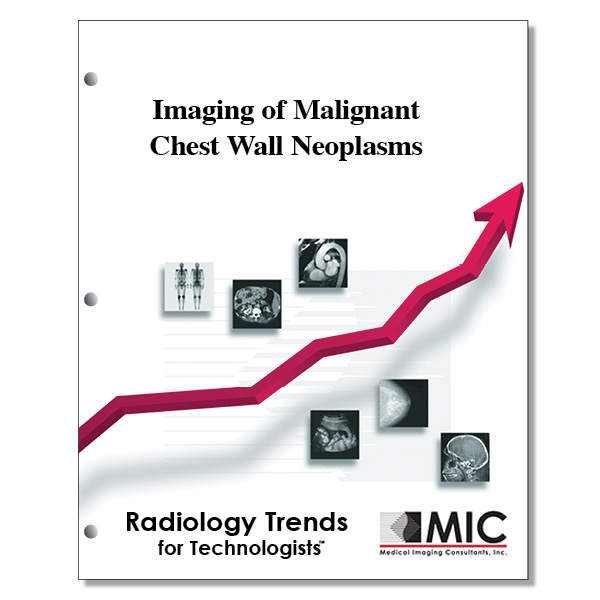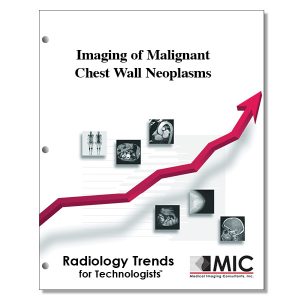

Imaging of Malignant Chest Wall Neoplasms
A presentation of imaging features that may be used to differentiate benign from malignant chest lesions, suggest specific histologic tumor types, and ultimately guide patient treatment.
Course ID: Q00506 Category: Radiology Trends for Technologists Modalities: CT, MRI, Radiation Therapy, Radiography2.75 |
Satisfaction Guarantee |
$29.00
- Targeted CE
- Outline
- Objectives
Targeted CE per ARRT’s Discipline, Category, and Subcategory classification for enrollments starting after February 17, 2023:
[Note: Discipline-specific Targeted CE credits may be less than the total Category A credits approved for this course.]
Computed Tomography: 2.00
Procedures: 2.00
Neck and Chest: 2.00
Magnetic Resonance Imaging: 2.00
Procedures: 2.00
Body: 2.00
Nuclear Medicine Technology: 2.00
Procedures: 2.00
Endocrine and Oncology Procedures: 2.00
Radiography: 1.00
Procedures: 1.00
Thorax and Abdomen Procedures: 1.00
Registered Radiologist Assistant: 2.00
Procedures: 2.00
Thoracic Section: 2.00
Radiation Therapy: 2.75
Patient Care: 1.75
Patient and Medical Record Management: 1.75
Procedures: 1.00
Treatment Sites and Tumors: 1.00
Outline
- Introduction
- Classification of Chest Wall Malignancies
- Evaluation of Chest Wall Malignancies
- Role of Imaging
- Differentiating Malignant from Benign Neoplasms
- Diagnosis and Histopathologic Tissue Sampling
- Primary Malignant Osseous Tumors
- Chondrosarcoma
- Myeloma
- Osteosarcoma
- Ewing Sarcoma Tumors
- Primary Malignant Soft-Tissue Neoplasms
- Adipocytic Neoplasms
- Vascular Neoplasms
- Nerve Sheath Neoplasms
- Cutaneous Neoplasms
- Fibrohistiocytic Neoplasms
- Secondary Neoplasms
- Metastatic Disease
- Chest Wall Invasion by Thoracic Malignancy
- Lymphoma
- Radiation-Associated Malignancies
- Treatment
- Conclusion
Objectives
Upon completion of this course, students will:
- be familiar with the percentage of thoracic malignancies on the chest wall
- be familiar with the key features of chest wall neoplasms
- identify the imaging modality that utilizes SUVs to distinguish disease
- be familiar with the most common finding of radiation-associated malignancies
- be familiar with the percentage of chest wall tumors detected at chest radiography
- be familiar with the organization that has created a classification system for soft-tissue neoplasms
- be familiar with the source of chest wall neoplasms
- be familiar with the osseous malignancies identified in the article
- identify the advantages of dual-energy subtraction chest radiography
- be familiar with routine cross-sectional imaging techniques used for the accurate characterization of chest wall malignancies
- identify the disadvantages of using multidetector CT to image chest wall malignancies
- identify the MR imaging sequences that are used to reduce the overall imaging time and minimize motion artifacts
- be familiar with the use of ultrasound to guide needle biopsy
- be familiar with the properties of hemangiomas
- be familiar with the techniques for histopathologic tissue sampling
- be familiar with biopsy techniques recommended for lesions less than 5 cm
- be familiar with the characteristics of an angiosarcoma
- be familiar with the CT multidetector findings that apply to UPS
- identify the most common primary osseous malignancy of the chest wall
- be familiar with the neoplasms that are comprised of malignant plasmacytes
- identify the symptoms reported with multiple myeloma
- be familiar with the demonstration of extramedullary plasmacytoma on MR
- be familiar with the characteristics of osteosarcoma
- be familiar with the characteristics of Ewing sarcoma
- identify what patients are most commonly affected by Ewing sarcoma
- be familiar with the imaging characteristics of Ewing sarcoma at multidetector CT
- be familiar with the pathologic subtypes of liposarcoma
- be familiar with the most common pathological subtypes of liposarcoma
- be familiar with the characteristics of angiosarcoma
- be familiar with the characteristics of MPNST neoplasms
- be familiar with the neoplasms associated with MPNST
- identify the key imaging features used to differentiate liposarcoma
- be familiar with the characteristics of DFSP
- be familiar with the UPS neoplasm
- identify the histologic subtypes of UPS
- be familiar with the common patterns of metastatic spread of secondary neoplasms
- be familiar with the advantages of MR when detecting chest wall invasion by lung cancer
- be familiar with the risk of radiation-associated secondary chest wall malignancy
- identify the treatment of choice for chest wall malignancies
- be familiar with treatment recommendations for chondrosarcoma
